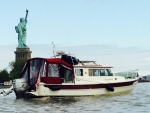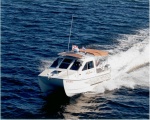| View previous topic :: View next topic |
| Author |
Message |
Pat Anderson
Joined: 02 Nov 2003
Posts: 8562
City/Region: Birch Bay, WA
State or Province: WA
C-Dory Year: 2005
C-Dory Model: 25 Cruiser
Vessel Name: Daydream
Photos: Daydream and Crabby Lou
|
 Posted: Sat Jun 07, 2014 12:21 pm Post subject: Converting Reserve Capacity Minutes to Amp Hours Posted: Sat Jun 07, 2014 12:21 pm Post subject: Converting Reserve Capacity Minutes to Amp Hours |
 |
|
OK, I need to know the Amp Hour (AH) rating for my house batteries, which are two NAPA Premium RV/Marine Deep Cycle batteries wired in parallel, in order to set up my Victron BVM 700 battery monitor. Each battery is rated at 160 minutes Reserve Capacity. The Victron BMV 700 (picked it up yesterday) needs to be set to the actual capacity of the batteries in AHs.
So I THINK I get there this way: Add the RC of each battery separately to get total RC. 160 + 160 = 320. Divide RC by 2.4. 320 / 2.4 = 133.33 AHs. The Victron defaults to 200 AHs on startup, so I will have to lower the setting to 0133 (four digit display). Agree, or am I missing something here?
The "divide by 2.4" is an alternate method that gives the same results as the technically correct method (copy and paste from eHowTo.com):
Instructions
1
Multiply the reserve capacity by 60 to convert it to seconds. For example, if a battery offers a 100-minute capacity: 100 x 60 = 6,000 seconds.
2
Multiply this length of time by 25, which is the battery's amperage. Example: 6,000 x 25 = 150,000. This is the number of Coulombs of charge in the battery.
3
Divide this answer by 3,600, which is the number of Coulombs in an amp-hour. Example: 150,000 ÷ 3,600 = 41.67. This is the number of amp-hours in the battery.
Tips & Warnings
To convert in a single step, divide the reserve capacity by 2.4.
_________________
DAYDREAM - 2005 CD25 Cruiser (sold July 2025)
CRABBY LOU - 1991 CD16 Angler (sold 2020)
Pat & Patty Anderson, C-Brat #62!
http://daydreamsloop.blogspot.com

|
|
| Back to top |
|
 |
TyBoo
Joined: 23 Oct 2003
Posts: 5326
City/Region: Warrenton
State or Province: OR
C-Dory Year: 1996
C-Dory Model: 25 Cruise Ship
Vessel Name: TyBoo
Photos: TyBoo
|
 Posted: Sat Jun 07, 2014 12:37 pm Post subject: Posted: Sat Jun 07, 2014 12:37 pm Post subject: |
 |
|
For steps two and three you must wear a tin foil hat to prevent any alien Coulombs from intermingling with resident cerebral Coulombs thus creating contrary Coulombs and contaminating the Coulomb pool. This is especially likely in situations of over thinking the situation. And thats all I know about that.
_________________
TyBoo Mike
Sold: 1996 25' Cruise Ship
Sold: 1987 22' Cruiser |
|
| Back to top |
|
 |
thataway
Joined: 02 Nov 2003
Posts: 21597
City/Region: Pensacola
State or Province: FL
C-Dory Year: 2007
C-Dory Model: 25 Cruiser
Vessel Name: thataway
Photos: Thataway
|
 Posted: Sat Jun 07, 2014 12:46 pm Post subject: Posted: Sat Jun 07, 2014 12:46 pm Post subject: |
 |
|
Some say divide by 2.4 some say divide 2 some say divide by 2 and add 16. The reality is unless that specific battery (batteries have different characteristics, when tested for AH vs RC, as related to discharge curves/vs current, temp etc) has been tested and certified at Amp Hours, it is just going to be a close guess. Also in reality, the battery capacity changes as you use it. You will be conservative setting at 133, but it is probably a little more than that, if you used the divide by2 and add 16.
It really does not make a lot of difference--and with the conservative number, you will be far less likely to damage the battery by deep discharge.
I try and not drop the steady state voltage to less than 12.2 volts. This gives you long life of the battery. If you don't pull more than 75 amps out of the battery between re-charges (66 2/3 if you use the number you have) you should have good use of the battery. I used those same NAPA batteries in a Road Trek RV for over 6 years and they worked very well.
_________________
Bob Austin
Thataway
Thataway (Ex Seaweed) 2007 25 C Dory May 2018 to Oct. 2021
Thisaway 2006 22' CDory November 2011 to May 2018
Caracal 18 140 Suzuki 2007 to present
Thataway TomCat 255 150 Suzukis June 2006 thru August 2011
C Pelican; 1992, 22 Cruiser, 2002 thru 2006
Frequent Sea; 2003 C D 25, 2007 thru 2009
KA6PKB
Home port: Pensacola FL |
|
| Back to top |
|
 |
Pat Anderson
Joined: 02 Nov 2003
Posts: 8562
City/Region: Birch Bay, WA
State or Province: WA
C-Dory Year: 2005
C-Dory Model: 25 Cruiser
Vessel Name: Daydream
Photos: Daydream and Crabby Lou
|
 Posted: Sat Jun 07, 2014 2:51 pm Post subject: Posted: Sat Jun 07, 2014 2:51 pm Post subject: |
 |
|
| The Victron shunt is now installed. On to mounting the display and running the cabling! |
|
| Back to top |
|
 |
Molly Brown
Joined: 02 Nov 2003
Posts: 419
City/Region: Punta Gorda
State or Province: FL
C-Dory Year: 2003
C-Dory Model: 24 Tomcat
Vessel Name: MOLLY BROWN
Photos: Molly Brown
|
 Posted: Sat Jun 07, 2014 3:10 pm Post subject: Posted: Sat Jun 07, 2014 3:10 pm Post subject: |
 |
|
Mile I'm with you. Bob's response is the same as yours to me, lol.
_________________
 James, Betty, Luna cat and Moki dog on the TomCat Molly Brown James, Betty, Luna cat and Moki dog on the TomCat Molly Brown
Started the Great American Loop 03/2024
Completed 01/2025 |
|
| Back to top |
|
 |
Aurelia
Joined: 21 Aug 2009
Posts: 2336
City/Region: Gig Harbor
State or Province: WA
Photos: Aurelia
|
 Posted: Sat Jun 07, 2014 4:06 pm Post subject: Posted: Sat Jun 07, 2014 4:06 pm Post subject: |
 |
|
Hi Pat,
Your NAPA batteries are regular lead acid and produced by Deka in the GP27 size so they should be 90AH rated each at the 20a rate so you have yourself 180AH for that new freezer of yours. I am assuming they are the same batteries as their Marine Master line which is a pretty safe assumption in that business. So your 133 value is conservative for sure.
See this spec sheet:
http://cdn.shopify.com/s/files/1/0033/6262/files/dc_series_PDF.pdf?1254611993
_________________
Greg, Cindie & Aven
Gig Harbor
Aurelia - 25 Cruiser sold 2012
Ari - 19 Cruiser sold 2023
currently exploring with "Lia", 17 ft Bullfrog Supersport Pilothouse |
|
| Back to top |
|
 |
ssobol
Joined: 27 Oct 2012
Posts: 3622
City/Region: SW Michigan
State or Province: MI
C-Dory Year: 2008
C-Dory Model: 22 Cruiser
Vessel Name: SoBELLE
Photos: SoBelle
|
 Posted: Sat Jun 07, 2014 4:14 pm Post subject: Posted: Sat Jun 07, 2014 4:14 pm Post subject: |
 |
|
| Doesn't it just say this on the battery? Usually in small text someplace because they are not usually marketed by amp hours. IME all the batteries I have seen have this marked on them somewhere. |
|
| Back to top |
|
 |
thataway
Joined: 02 Nov 2003
Posts: 21597
City/Region: Pensacola
State or Province: FL
C-Dory Year: 2007
C-Dory Model: 25 Cruiser
Vessel Name: thataway
Photos: Thataway
|
 Posted: Sat Jun 07, 2014 6:30 pm Post subject: Posted: Sat Jun 07, 2014 6:30 pm Post subject: |
 |
|
| I looked at my Sam's Duracell, AGM batteries, which are the same as the East Penn (Deka) "Intimidator", and they have the same amp hour and residual capacity as the flooded lead acid batteries, in the same size case--as Greg posted in the link. But the AGM batteries weigh 10# more. (which means 10# more lead. The group 31 in the AGM (and flooded lead acid) are 200 residual cap and 105 amp hours. (Also the group 31 comes with 3/8" post rather then 5/16" post). |
|
| Back to top |
|
 |
bcassal
Joined: 20 Sep 2008
Posts: 193
City/Region: BLoomington
State or Province: IN
C-Dory Year: 2002
C-Dory Model: 22 Cruiser
Vessel Name: Carpy
Photos: Carpy
|
 Posted: Sun Jun 08, 2014 9:00 pm Post subject: Posted: Sun Jun 08, 2014 9:00 pm Post subject: |
 |
|
I called my friendly NAPA store and asked them. They got back to me with the rating which was not on the batteries.
Carpy |
|
| Back to top |
|
 |
jkidd
Joined: 23 Oct 2006
Posts: 1677
City/Region: Northern, Utah
State or Province: UT
C-Dory Year: 2007
C-Dory Model: 22 Cruiser
Vessel Name: Voyager
Photos: Voyager (JK)
|
 Posted: Sun Jun 08, 2014 10:56 pm Post subject: Posted: Sun Jun 08, 2014 10:56 pm Post subject: |
 |
|
In the manual it says to use the 20 amp hour rating. So 2 batteries in parallel should be times 2.
_________________
Jody Kidd
KE7WNG
Northern, Utah
 |
|
| Back to top |
|
 |
journey on
Joined: 03 Mar 2005
Posts: 3599
City/Region: Valley Centre
State or Province: CA
C-Dory Year: 2005
C-Dory Model: 25 Cruiser
Vessel Name: journey on
Photos: Journey On
|
 Posted: Mon Jun 09, 2014 12:44 am Post subject: Posted: Mon Jun 09, 2014 12:44 am Post subject: |
 |
|
There is a relationship between reserve capacity in minutes and amp hours which might give some insight into how to get a meaningful amp-hr rating from reserve capacity.
First, reserve capacity is defined the number of minutes a fully charged battery at 80 ° F will discharge 25 amps until the battery drops below 10.5 volts. Note the 10.5 volts, that's certainly lower than one would want to go, but that's the definition. And 25 amps output is a tough test for a battery.
So the amp-hrs produced is 25 amps time the minutes/60, right? So using Pat's batteries as a baseline, we get 25 amps*160 min/(60 min/hr)=67 amp-hrs per battery. The 2.4 used above is simply 60/25, so Pat got it right. And Pat has 2 batteries so 67+67=134
A Group 24 flooded battery is rated for 75 amps (West Marine catalog), so though Pat doesn't say, I assume those are Group 24 batteries.
Now, an important consideration is making the battery last. Discharging a lead-acid battery to 10.5 VDC is going to kill it real quick. A good rule of thumb is to use 50% of A-H capacity. Therefore, Pat has 67 amp-hrs available. And he ought to monitor the Vectron monitor so that he doesn't exceed that.
Also, AGM batteries have the acid retained by fiberglass mats and require relief valves to eliminate overpressure from any fast charging.. I would assume that they are heavier than equivalent flooded batteries because of the added equipment, not necessarily from added lead. And the case size is the same, so getting more lead in is problematical.
Boris |
|
| Back to top |
|
 |
Pat Anderson
Joined: 02 Nov 2003
Posts: 8562
City/Region: Birch Bay, WA
State or Province: WA
C-Dory Year: 2005
C-Dory Model: 25 Cruiser
Vessel Name: Daydream
Photos: Daydream and Crabby Lou
|
 Posted: Mon Jun 09, 2014 12:46 am Post subject: Posted: Mon Jun 09, 2014 12:46 am Post subject: |
 |
|
Jody, what manual? My batteries have an RC rating only, no AH rating. I am going with the "conservative" conversion from 160 RC x 2 (320 RC) to 133 AH. Maybe right, maybe wrong, we shall see! Boat is outside right now, with the solar panels pumping out energy all afternoon. Middle of the afternoon, the Victron said we were putting 5 amps into the batteries. All day long, SOC was at 100%. In the dark, no energy being made, no load, the Victron said 99.99% SOC. I will check in the morning and see what we have! Tomorrow I will hook up the ARB 50 quart fridge/freezer, and see that that load does to the batteries. I can hardly wait to get to Powell, where we will have some real sunshine!
Last edited by Pat Anderson on Mon Jun 09, 2014 12:58 am; edited 2 times in total |
|
| Back to top |
|
 |
Pat Anderson
Joined: 02 Nov 2003
Posts: 8562
City/Region: Birch Bay, WA
State or Province: WA
C-Dory Year: 2005
C-Dory Model: 25 Cruiser
Vessel Name: Daydream
Photos: Daydream and Crabby Lou
|
 Posted: Mon Jun 09, 2014 12:56 am Post subject: Posted: Mon Jun 09, 2014 12:56 am Post subject: |
 |
|
| Boris, I agree, we do not want to kill these batteries! So will be watching the Victron really close for a while!. I am thinking though that with the ARB at a max 1.3 amps and the other loads like our LED lights being really low, we should be just fine. The only question is what load Webasto may put on the batteries, but this time of year, we don't need to run, it so that is a question to answer in the future! |
|
| Back to top |
|
 |
jkidd
Joined: 23 Oct 2006
Posts: 1677
City/Region: Northern, Utah
State or Province: UT
C-Dory Year: 2007
C-Dory Model: 22 Cruiser
Vessel Name: Voyager
Photos: Voyager (JK)
|
 Posted: Mon Jun 09, 2014 9:16 am Post subject: Posted: Mon Jun 09, 2014 9:16 am Post subject: |
 |
|
| Pat Anderson wrote: | Jody, what manual? My batteries have an RC rating only, no AH rating. I am going with the "conservative" conversion from 160 RC x 2 (320 RC) to 133 AH. Maybe right, maybe wrong, we shall see! Boat is outside right now, with the solar panels pumping out energy all afternoon. Middle of the afternoon, the Victron said we were putting 5 amps into the batteries. All day long, SOC was at 100%. In the dark, no energy being made, no load, the Victron said 99.99% SOC. I will check in the morning and see what we have! Tomorrow I will hook up the ARB 50 quart fridge/freezer, and see that that load does to the batteries. I can hardly wait to get to Powell, where we will have some real sunshine!
|
The 180 AH previously mentioned sounds like a good number. You should be able to measure the voltage and make adjustments to make it more accurate. Here's the manual http://www.c-brats.com/viewtopic.php?p=262202#262202 |
|
| Back to top |
|
 |
thataway
Joined: 02 Nov 2003
Posts: 21597
City/Region: Pensacola
State or Province: FL
C-Dory Year: 2007
C-Dory Model: 25 Cruiser
Vessel Name: thataway
Photos: Thataway
|
 Posted: Mon Jun 09, 2014 9:49 am Post subject: Posted: Mon Jun 09, 2014 9:49 am Post subject: |
 |
|
| journey on wrote: | Note the 10.5 volts, that's certainly lower than one would want to go, but that's the definition. And 25 amps output is a tough test for a battery.
A Group 24 flooded battery is rated for 75 amps (West Marine catalog), so though Pat doesn't say, I assume those are Group 24 batteries.
Also, AGM batteries have the acid retained by fiberglass mats and require relief valves to eliminate overpressure from any fast charging.. I would assume that they are heavier than equivalent flooded batteries because of the added equipment, not necessarily from added lead. And the case size is the same, so getting more lead in is problematical.
Boris |
You don't ever want to discharge batteries to 10.5 volts. 12.2 is generally recognized as the end point. There are a number of tables of depth of discharge vs longevity of the battery. 12.2 volts is a good compromise between usable power and longevity.
Yes, there is a gel , and fiberglass mat, with valves, but no battery caps etc--the valves are simple and don't weigh much. The amount of lead put into a battery size case can vary (as can the weight) AGM batteries are built differently than flooded lead acid batteries and due to this construction more lead can be put into the battery. An AGM battery uses a separator consisting of fiberglass between the plate and wrappers to hold the electrolyte in its place with capillary action. Combining the lead plates, electrolyte, and fiber glass separation fibers in a confined space, AGM batteries create a "physical bond" by way of capillary action. There is not the space between plates, and plates can be thinner.
If you really want longevity from the battery, go with Rolls.
With out Group 31 dedicated to the freezer, at Lake Powell, we monitor the battery, and it stays above 12.2 volts, with a recharge of about 2 hours out of every 24 from a 30 amp battery charger via the Honda EU 1000. We have not tried it with solar panels. It will be interesting to see if Pat's solar panel will keep up with the demand. I suspect it will. |
|
| Back to top |
|
 |
|
|
You cannot post new topics in this forum
You cannot reply to topics in this forum
You cannot edit your posts in this forum
You cannot delete your posts in this forum
You cannot vote in polls in this forum
You cannot attach files in this forum
You cannot download files in this forum
|
|

 Search
Search Private Messages
Private Messages Profile
Profile Log in
Log in Register
Register Help
Help


 James, Betty, Luna cat and Moki dog on the TomCat Molly Brown
James, Betty, Luna cat and Moki dog on the TomCat Molly Brown
